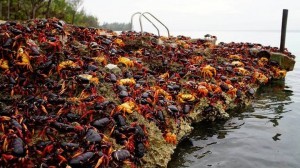Cuba’s Bay of Pigs has been invaded again, this time not by U.S.-backed anti-Castro forces, but by millions of red, yellow and black landcrabs.
Each year, after the first spring rains, the crabs march for days from the surrounding forests to the bay on Cuba’s southern coast to spawn in the sea, wreaking havoc along the way.
At dawn and dusk they emerge, scuttling sideways toward the sea, climbing up house walls and carpeting the coastal road that curves around the bay. The stench of crushed crab fills the air and their sharp shells puncture car tires.
“Thirty to 40 can enter without you even realizing it,” said Edian Villazon, who runs a food hut opposite the sea, which does not serve up crab meat. Cubans believe this type is toxic. “We have to always keep the door shut.”
The Bay of Pigs, where in 1961 Cuban exiles landed in a failed attempt to end Fidel Castro’s revolution, lies within a national park where 80 percent of Cuba’s endemic birds, along with crocodiles and other wildlife, can be observed. With its deep sinkholes, coral reefs and turquoise waters, the bay is known as one of Cuba’s best spots for diving. Visitors have spiked in recent years, in tandem with the overall tourism boom since the U.S.-Cuban detente.
“It’s very surprising and impressive to see so many crabs in one go and to watch them crossing so quickly,” said 36-year-old French tourist Emilie Lannegrand, adding it was “a little heartbreaking” to see so many crushed on the road.
source: reuters







Ask me anything
Explore related questions





